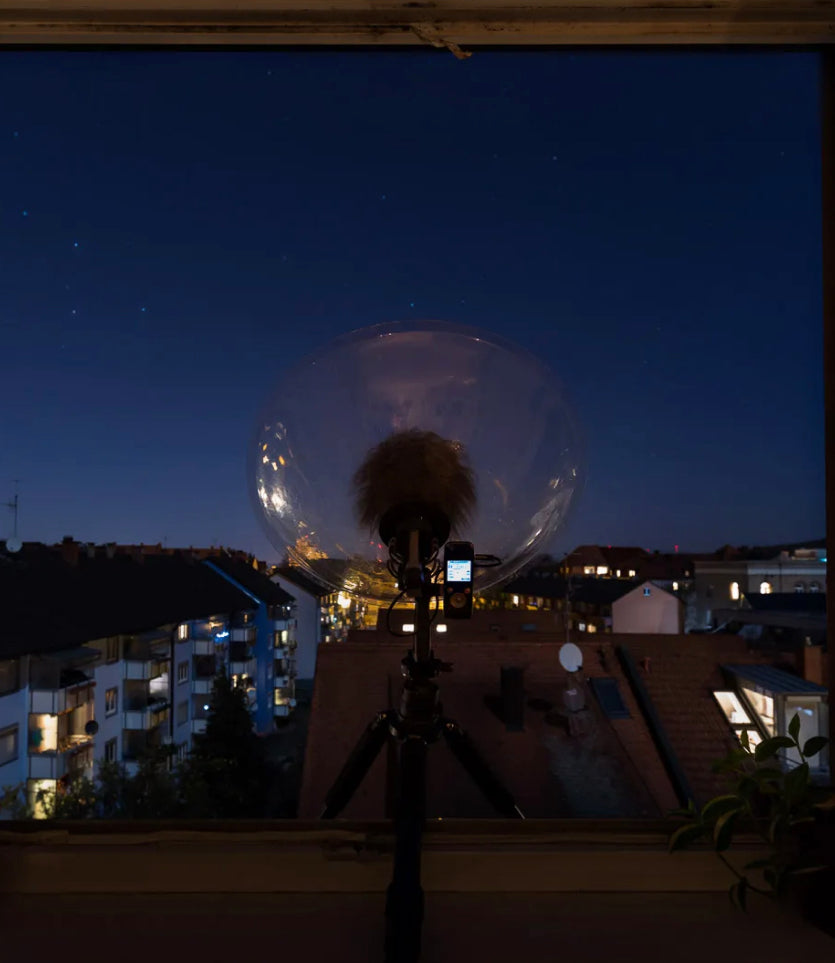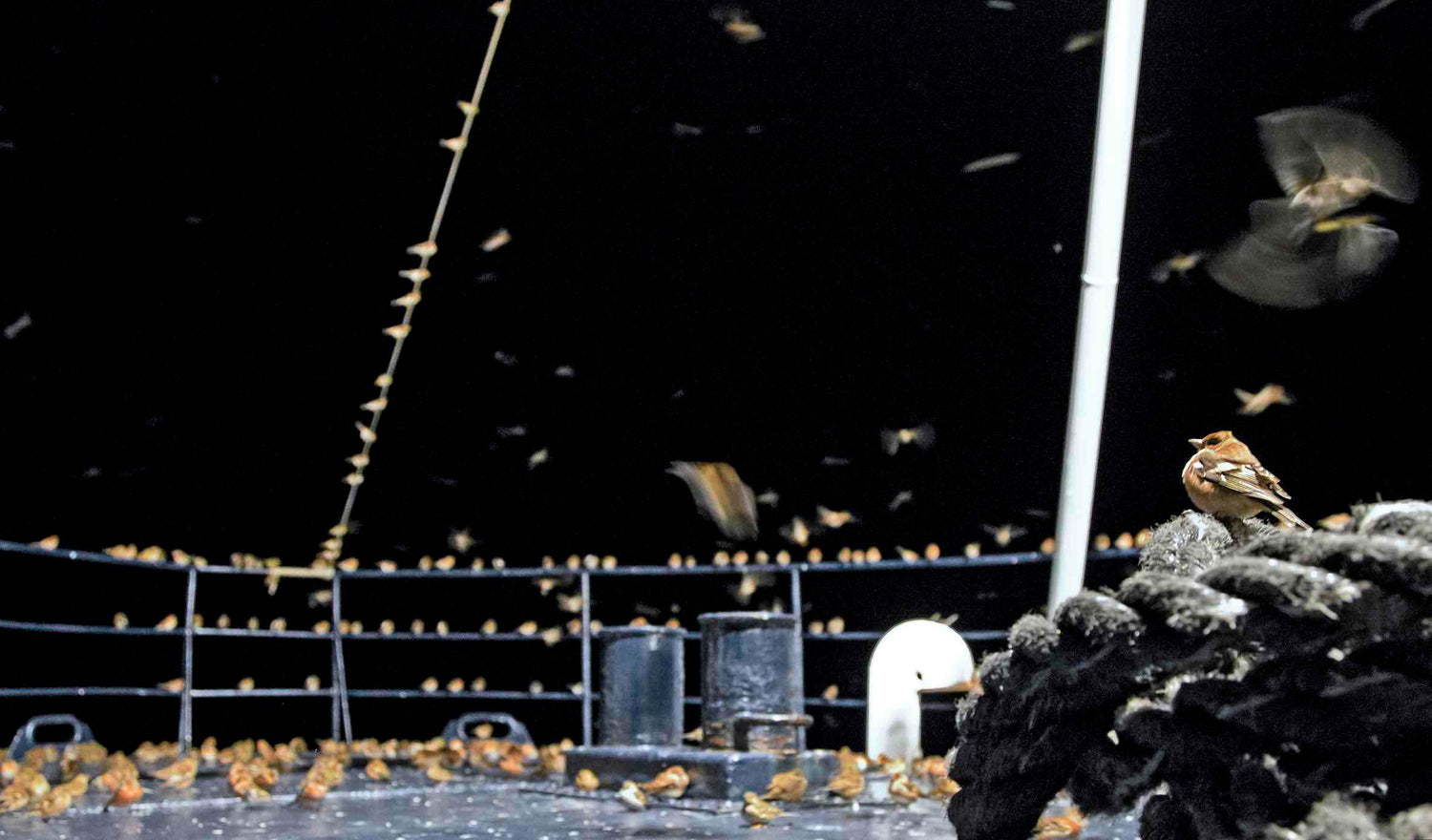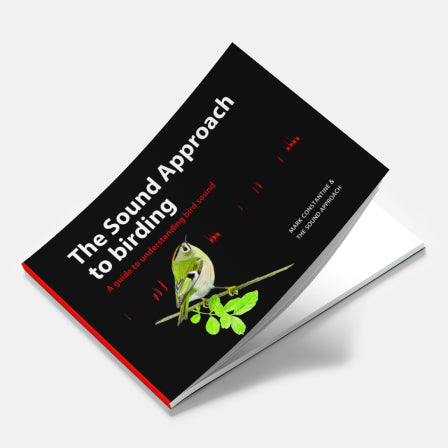
Understanding bird sounds
'Nocmig'
The science of nocturnal migration

HIDDEN SOUNDS
A new world
While it is now fairly popular to watch birds migrating at daytime, you may have wondered, how on earth can we experience bird migration at night? For some groups such as waders and most herons, migration by day or by night is much the same thing. This means that at night you can hear the same diagnostic calls crossing the sky, just as you could during the day, only now you rely entirely on your ears to know what is going on.
Explore nocmig calls
Some of the species you might encounter
Introduction to nocmig
Listening to nocturnal migration is a niche activity but growing in popularity to the point that it has its own nickname: ‘nocmig’ (from ‘nocturnal migration’). A big difference from ‘vismig’ is that many birds pass undetected: we can only detect the ones that call. Many individuals and even flocks belong to species with flight calls but choose not to use them. In addition, there are large taxonomic groups for which we have not yet detected any flight calls, such as most warblers Sylviidae. We think that this disadvantage is more than compensated by everything we can learn, and would otherwise never know, from the birds that do call. If you are interested in a more exhaustive introduction to nocturnal activity in birds, see Martin (1990).
There are two main approaches to nocmig: you can either sit outside, perhaps even at your favourite vismig spot, and listen to the birds calling overhead, or you can leave recording gear outside, giving you the opportunity to check identifications later, or simply because you need your nights for sleeping. In fact, the strongest nocturnal flight call activity often occurs towards the end of the night, when very few people are awake.
Species
Herons and bitterns
- Eurasian Bittern Botaurus stellaris
- Little Bittern Ixobrychus minutus
- Black-crowned Night Heron Nycticorax nycticorax
Waders
- Little Ringed Plover Charadrius dubius
- Eurasian Whimbrel Numenius phaeopus
- Eurasian Curlew Numenius arquata
- Bar-tailed Godwit Limosa lapponica
- Common Sandpiper Actitis hypoleucos
- Green Sandpiper Tringa ochropus
- Common Greenshank Tringa nebularia
- Wood Sandpiper Tringa glareola
- Common Redshank Tringa totanus
Thrushes
- Ring Ouzel Turdus torquatus
- Common Blackbird Turdus merula
- Song Thrush Turdus philomelos
- Redwing Turdus iliacus
Chats and old world flycatchers
- Spotted Flycatcher Muscicapa striata
- European Robin Erithacus rubecula
- Black Redstart Phoenicurus ochruros
- European Pied Flycatcher Ficedula hypoleuca
Wagtails and pipits
Deciphering nocmig
Many of us have struggled to make sense of the birds we hear at night. We do our best to compare calls with what we remember from daytime, recordings from our own collections and archives such as Xeno-canto. We consult collections of daytime flight calls such as Out of the blue or Birds in flight, and articles on nocturnal flight calls on websites such as this one or nocmig.com. At the time of writing, only Eastern North America has a comprehensive nocmig guide – Flight calls of Migratory Birds (Evans & O’Brien 2002).
In the past, a number of studies tried to quantify nocturnal migration (Martin 1990 and Newton 2008). Radar studies, for example, have the advantage of being able to detect and quantify birds flying at high altitudes, but a disadvantage is that most birds cannot be identified to species level. When listening to nocturnal migration it is basically the other way around. We can identify most callers to species level, but it is more difficult to estimate numbers, and impossible to detect birds that do not call, except for those passing close enough for their wingbeats to be audible to us.
This guide will try to fulfil the need for a thorough guide to nocturnal flight calls in Europe, while serving both approaches to nocmig. For the sheer pleasure of sitting outside and listening live, it can help with carefully chosen examples, descriptions of calls, and information on where and when you are most likely to hear a certain species. For the analysis of your sound-recording, it explains how to identify calls via sonagrams (graphs plotting frequency along time, also known as spectrograms), and the measurements that can be obtained from them. If you are unsure where, when and how to record and what to log, there is A Protocol For Standardised Nocturnal Flight Call Monitoring, which gives further advice for obtaining nocmig data.
We have covered the nocturnal migrants we judge most likely to be recorded giving flight calls during nocmig sessions in western and central Europe. We will not include wildfowl, as their calls are the same day and night, and there are plenty recordings available elsewhere. For Common Scoter see this earlier article.
Making sonagrams
For some of the more difficult species, measurements on a sonagram will be one of the best ways to secure the identification. We make ours in Raven Pro, although there are several other applications that can be used for this.
Unidentified sounds (UFOs)
Some calls can be very hard to identify by ear, especially if they are rare in your area or differ strongly from the norm. Whether you are listening live or studying sonagrams, it is normal for many calls to remain unidentified. If you make recordings, you will probably accumulate many UFO’s: tantalising mysteries that may bug you for years until, eventually, you solve a few of them. Beware that mammals (especially Red Fox Vulpes vulpes: for examples see British Library 2012), as well as amphibians, reptiles and insects also vocalise at night. An unexplained, bird-like sound could even come from something as innocent as a rusty bicycle hitting a small pothole two blocks away. In short, it is always sensible to err on the side of caution, especially until you have built up some experience. Avoid the temptation to name every sound that you hear.
Try this exercise to help you. During your first nocturnal recording sessions, sit outside while the recorder is running, listen to everything you can hear and take notes when you hear something man-made. If you cannot identify it immediately, try to find out what caused it, even if it was only a chestnut falling on the roof of your garage. Later you may stumble upon the same sound in your recording and will not lose much time wondering what it was.
Something else to be wary of is that in many locations, local birds may start singing several hours before dawn, both in spring and in autumn (mostly European Robins). If these birds are far enough away, only fragments of their songs may reach you or your microphones, and they may lead to false impressions of distant flight calls. Most experienced nocmig enthusiasts could probably tell you a story or two about when they were fooled in this way.
Acknowledgements
The recordings in this guide will be mostly from the collections of The Sound Approach, Lukas Pelikan and some long-term ‘nocmig colleagues’ including Nick Hopper, Steve Klasan and Tom Wulf. When they are from The Sound Approach, the recordist’s name is indicated by his initials in the serial number. Most are by Magnus Robb (MR); others are by Arnoud B van den Berg (AB), Mark Constantine (MC), Dick Forsman (DF), Killian Mullarney (KM) and Paul Morton (PM). We have also sent equipment to collaborators. They are: Geoffrey Morrison (GM) at Sagres in Portugal, the Besh Barmag (BB) team in Azerbaijan, John Bowler (JBr) on Tiree in Scotland, Nuno Vieira (NV) of the STRIX team in eastern Tunisia, Jem Babbington (JBn) near Dhahran in Saudi Arabia, Jon Strandberg (JS) at Paralimni on Cyprus, Thor Veen (TV) in British Columbia and Pierre-André Crochet (PAC) on Corvo and Alexandre Leitão (AL) on Flores, both islands in the Azores. All such recordings were analysed by MR, whose initials are included in the file names. The initials of the actual recordist, as indicated above, will be shown in brackets after the location. Many other recordists have kindly made their own recordings available to use and their names are in full in the captions.
We would like to say a special thank you to those who have recorded nocturnal migration for us. Our most dedicated helpers have been Geoffrey Morrison at Sagres in Portugal in 2017-2019 and the Besh Barmag team in Azerbaijan in 2018 and 2019 (especially Michael Heiß, Zülfü Fərəcli and Elvin Məmmədsoy). We are also grateful for the help of Jem Babbington in Saudi Arabia, John Bowler in Scotland, Pierre-André Crochet on Corvo and and Alexandre Leitão on Flores, Azores, Jon Strandberg in Cyprus, Klas Strandberg in Sweden, Thor Veen in British Columbia and Nuno Vieira in Tunisia.
Many correspondents have shared recordings and ideas, and to all of them we are very grateful. For the species covered so far, contributions from Jonas Buddemeier, Frédéric Cazaban, David Darrell-Lambert, Margus Ellermaa, Nicholas Galea, Nick Hopper, Steve Klasan, Ralph Martin, Ireneusz Oleksik, Eduardo Realinho, Julien Rochefort, Seán Ronayne, Albert Cama Torrell, Stanislas Wroza and Tom Wulf have been particularly helpful. Other names will appear here as the guide expands.
Special thanks to Martin Grimm, Michael Heiß, Ralph Martin and Pim Wolf for the photos that appear in the introduction.
For inspiration and setting high standards, we would like to honour pioneers in North America: in particular Bill Evans, Andrew Farnsworth, Michael Lanzone and Michael O’Brien. And last but not least, a European pioneer from the 19th century: Johann Friedrich Naumann, who was not only a true birder and keen observer but also knew a lot about nocturnal flight calls.
Literature
British Library 2012. Sounds of the night: An audio guide to Britain’s nocturnal species. Audio CD. London.
Evans, W R & O’Brien, M 2002. Flight calls of migratory birds. Eastern North American landbirds.
Gill, F & Donsker, D 2019. Birds of the world: recommended English names.
Martin, G 1990. Birds by night. London
Newton, I 2008. The migration ecology of birds. London.

The Sound Approach to Birding
The book that started it all, By Mark Constantine and The Sound Approach. No matter what your level of knowledge, with “The Sound Approach to Birding”, you will enhance your field skills and improve your standards of identification whilst listening to over 200 high quality sound recordings.

 Little Grebe
Little Grebe
 Common Quail
Common Quail
 Black-crowned Night Heron
Black-crowned Night Heron
 Black Redstart
Black Redstart
 Eurasian Whimbrel
Eurasian Whimbrel
 Little Bittern
Little Bittern
 Common Sandpiper
Common Sandpiper
 Spotted Crake
Spotted Crake
 Common Blackbird
Common Blackbird
 Common Greenshank
Common Greenshank
 Green Sandpiper
Green Sandpiper
 Common Redshank
Common Redshank
 European Pied Flycatcher
European Pied Flycatcher
 European Robin
European Robin
 Meadow Pipit
Meadow Pipit
 Wood Sandpiper
Wood Sandpiper
 Bar-tailed Godwit
Bar-tailed Godwit
 Redwing
Redwing
 Ring Ouzel
Ring Ouzel
 Eurasian Bittern
Eurasian Bittern